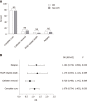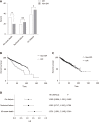Comparison of clinical features and outcomes in peritoneal dialysis-associated peritonitis patients with and without diabetes: A multicenter retrospective cohort study
- PMID: 33133391
- PMCID: PMC7582114
- DOI: 10.4239/wjd.v11.i10.435
Comparison of clinical features and outcomes in peritoneal dialysis-associated peritonitis patients with and without diabetes: A multicenter retrospective cohort study
Abstract
Background: The number of end-stage renal disease patients with diabetes mellitus (DM) who are undergoing peritoneal dialysis is increasing. Peritoneal dialysis-associated peritonitis (PDAP) is a serious complication of peritoneal dialysis leading to technical failure and increased mortality in patients undergoing peritoneal dialysis. The profile of clinical symptoms, distribution of pathogenic organisms, and response of PDAP to medical management in the subset of end-stage renal disease patients with DM have not been reported previously. Discrepant results have been found in long-term prognostic outcomes of PDAP in patients with DM. We inferred that DM is associated with bad outcomes in PDAP patients.
Aim: To compare the clinical features and outcomes of PDAP between patients with DM and those without.
Methods: In this multicenter retrospective cohort study, we enrolled patients who had at least one episode of PDAP during the study period. The patients were followed for a median of 31.1 mo. They were divided into a DM group and a non-DM group. Clinical features, therapeutic outcomes, and long-term prognostic outcomes were compared between the two groups. Risk factors associated with therapeutic outcomes of PDAP were analyzed using multivariable logistic regression. A Cox proportional hazards model was constructed to examine the influence of DM on patient survival and incidence of technical failure.
Results: Overall, 373 episodes occurred in the DM group (n = 214) and 692 episodes occurred in the non-DM group (n = 395). The rates of abdominal pain and fever were similar in the two groups (P > 0.05). The DM group had more infections with coagulase-negative Staphylococcus and less infections with Escherichia coli (E. coli) as compared to the non-DM group (P < 0.05). Multivariate logistic regression analysis revealed no association between the presence of diabetes and rates of complete cure, catheter removal, PDAP-related death, or relapse of PDAP (P > 0.05). Patients in the DM group were older and had a higher burden of cardiovascular disease, with lower level of serum albumin, but a higher estimated glomerular filtration rate (P < 0.05). Cox proportional hazards model confirmed that the presence of diabetes was a significant predictor of all-cause mortality (hazard ratio = 1.531, 95% confidence interval: 1.091-2.148, P < 0.05), but did not predict the occurrence of technical failure (P > 0.05).
Conclusion: PDAP patients with diabetes have similar symptomology and are predisposed to coagulase-negative Staphylococcus but not E. coli infection compared those without. Diabetes is associated with higher all-cause mortality but not therapeutic outcomes of PDAP.
Keywords: Diabetes mellitus; Mortality; Peritoneal dialysis; Peritoneal dialysis-associated peritonitis; Technical failure.
©The Author(s) 2020. Published by Baishideng Publishing Group Inc. All rights reserved.
Conflict of interest statement
Conflict-of-interest statement: All the authors declare that they have no conflict of interest.
Figures



Similar articles
-
[Clinical characteristics and treatment outcomes of first peritonitis in patients receiving long-term peritoneal dialysis: a multicenter study].Nan Fang Yi Ke Da Xue Xue Bao. 2020 Dec 30;40(12):1740-1746. doi: 10.12122/j.issn.1673-4254.2020.12.07. Nan Fang Yi Ke Da Xue Xue Bao. 2020. PMID: 33380390 Free PMC article. Chinese.
-
Influence of Early-Onset Peritonitis on Mortality and Clinical Outcomes in ESRD Patients with Diabetes Mellitus on Peritoneal Dialysis: A Retrospective Multicenter Study.Blood Purif. 2022;51(3):280-287. doi: 10.1159/000514938. Epub 2021 Oct 12. Blood Purif. 2022. PMID: 34638121
-
[Risk factors of occurrence and treatment failure of peritoneal dialysis-associated polymicrobial peritonitis: a multicenter retrospective study].Nan Fang Yi Ke Da Xue Xue Bao. 2021 Aug 31;41(9):1350-1357. doi: 10.12122/j.issn.1673-4254.2021.09.09. Nan Fang Yi Ke Da Xue Xue Bao. 2021. PMID: 34658349 Free PMC article. Chinese.
-
Multidrug-resistant organism-peritoneal dialysis associated peritonitis: clinical and microbiological features and risk factors of treatment failure.Front Med (Lausanne). 2023 May 10;10:1132695. doi: 10.3389/fmed.2023.1132695. eCollection 2023. Front Med (Lausanne). 2023. PMID: 37234246 Free PMC article.
-
Peritoneal dialysis peritonitis due to Neisseria: clinicopathological features of 10 patients with a review of the literature.Ren Fail. 2025 Dec;47(1):2466820. doi: 10.1080/0886022X.2025.2466820. Epub 2025 Feb 26. Ren Fail. 2025. PMID: 40012242 Free PMC article. Review.
Cited by
-
Linking clinical manifestations and causative organisms may provide clues for the treatment of peritoneal dialysis-associated peritonitis.BMC Nephrol. 2024 Sep 27;25(1):322. doi: 10.1186/s12882-024-03756-y. BMC Nephrol. 2024. PMID: 39334001 Free PMC article.
-
Development and validation of a nomogram for predicting refractory peritoneal dialysis related peritonitis.Ren Fail. 2024 Dec;46(2):2368083. doi: 10.1080/0886022X.2024.2368083. Epub 2024 Jul 3. Ren Fail. 2024. PMID: 38958248 Free PMC article.
-
Development of a clinical risk score system for peritoneal dialysis-associated peritonitis treatment failure.BMC Nephrol. 2023 Aug 7;24(1):229. doi: 10.1186/s12882-023-03284-1. BMC Nephrol. 2023. PMID: 37550622 Free PMC article.
-
Acute Peritoneal Dialysis in a Patient with Severe Uremic Syndrome and Multiple Hemodialysis Access Failure.Case Rep Nephrol. 2024 Aug 5;2024:8891887. doi: 10.1155/2024/8891887. eCollection 2024. Case Rep Nephrol. 2024. PMID: 39135880 Free PMC article.
-
Construction and validation of a predictive model for the risk of peritoneal dialysis-associated peritonitis after peritoneal dialysis catheterization.Front Med (Lausanne). 2023 Sep 15;10:1193754. doi: 10.3389/fmed.2023.1193754. eCollection 2023. Front Med (Lausanne). 2023. PMID: 37790129 Free PMC article.
References
-
- Tang SCW, Yu X, Chen HC, Kashihara N, Park HC, Liew A, Goh BL, Nazareth MGC, Bunnag S, Tan J, Lun V, Lydia A, Sharma SK, Hoque E, Togtokh A, Ghnaimet M, Jha V. Dialysis Care and Dialysis Funding in Asia. Am J Kidney Dis. 2020;75:772–781. - PubMed
-
- Coimbra S, Reis F, Nunes S, Viana S, Valente MJ, Rocha S, Catarino C, Rocha-Pereira P, Bronze-da-Rocha E, Sameiro-Faria M, Oliveira JG, Madureira J, Fernandes JC, Miranda V, Belo L, Santos-Silva A. The Protective Role of Adiponectin for Lipoproteins in End-Stage Renal Disease Patients: Relationship with Diabetes and Body Mass Index. Oxid Med Cell Longev. 2019;2019:3021785. - PMC - PubMed
-
- Li PK, Chow KM, Van de Luijtgaarden MW, Johnson DW, Jager KJ, Mehrotra R, Naicker S, Pecoits-Filho R, Yu XQ, Lameire N. Changes in the worldwide epidemiology of peritoneal dialysis. Nat Rev Nephrol. 2017;13:90–103. - PubMed
LinkOut - more resources
Full Text Sources
Research Materials

